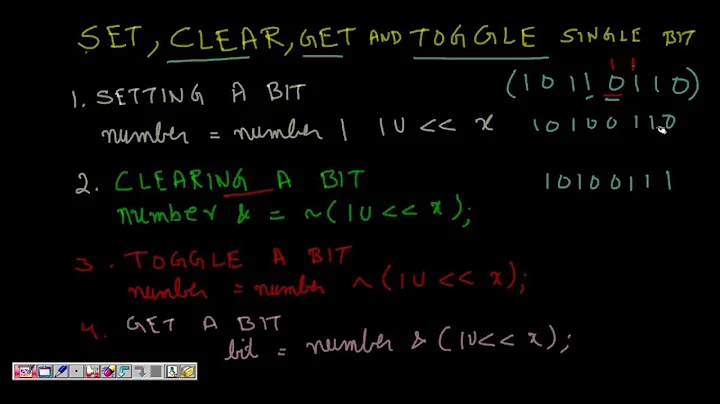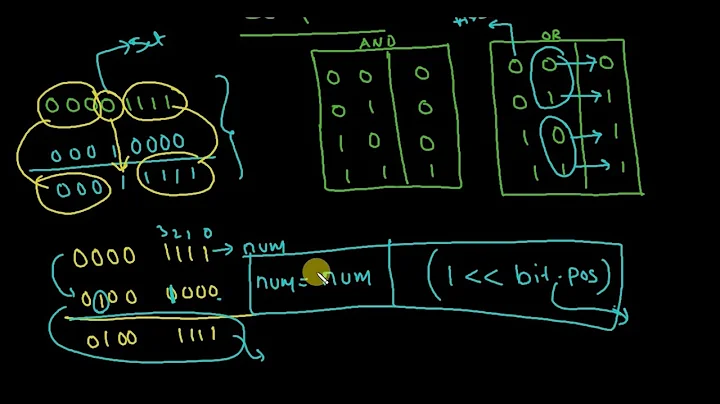How would you set and clear a single bit in Go?
Solution 1
Here's a function to set a bit. First, shift the number 1 the specified number of spaces in the integer (so it becomes 0010, 0100, etc). Then OR it with the original input. This leaves the other bits unaffected but will always set the target bit to 1.
// Sets the bit at pos in the integer n.
func setBit(n int, pos uint) int {
n |= (1 << pos)
return n
}
Here's a function to clear a bit. First shift the number 1 the specified number of spaces in the integer (so it becomes 0010, 0100, etc). Then flip every bit in the mask with the ^ operator (so 0010 becomes 1101). Then use a bitwise AND, which doesn't touch the numbers AND'ed with 1, but which will unset the value in the mask which is set to 0.
// Clears the bit at pos in n.
func clearBit(n int, pos uint) int {
mask := ^(1 << pos)
n &= mask
return n
}
Finally here's a function to check whether a bit is set. Shift the number 1 the specified number of spaces (so it becomes 0010, 0100, etc) and then AND it with the target number. If the resulting number is greater than 0 (it'll be 1, 2, 4, 8, etc) then the bit is set.
func hasBit(n int, pos uint) bool {
val := n & (1 << pos)
return (val > 0)
}
Solution 2
There is also a compact notation to clear a bit. The operator for that is &^ and called "and not".
Using this operator the clearBit function can be written like this:
// Clears the bit at pos in n.
func clearBit(n int, pos uint) int {
n &^= (1 << pos)
return n
}
Or like this:
// Clears the bit at pos in n.
func clearBit(n int, pos uint) int {
return n &^ (1 << pos)
}
Related videos on Youtube
Kevin Burke
I build reliable software and design great experiences. I'm available for hire: https://burke.services
Updated on July 23, 2022Comments
-
Kevin Burke almost 2 years
In Golang, how do you set and clear individual bits of an integer? For example, functions that behave like this:
clearBit(129, 7) // returns 1 setBit(1, 7) // returns 129 -
twotwotwo about 10 yearsNote it might be simpler to just write
x &= ^(1<<7)orx |= 1<<7(orx ^= 1<<7to toggle, or(x & 1<<7 == 0)to see if a bit is set). That's widely understood enough not to need a comment, but if you feel like you should explain (e.g., your team doesn't come from a bit-twiddling world), just comment about your intention on first use of each idiom. Also, folks often define constants representing bits or bit combos so they don't have to write out1<<nand remember the rightneach time, andiotacan help make those constant declarations concise. -
Kevin Burke about 10 yearsAgreed, I just extracted the variables to help clarity/readability. It is possible the compiler is making these optimizations as well.
-
Jonguo almost 3 yearsfunc hasBit(n int, pos uint) bool { val := n & (1 << pos) return !(val == 0) } hasBit should like this, when n = -1<<63 and pos == 63, val is <0 but the leading bit is 1
![Calling conventions and single-step execution - 16-bit Intel x86 breadboard computer [part 5]](https://i.ytimg.com/vi/O73qC3VFngA/hqdefault.jpg?sqp=-oaymwEcCOADEI4CSFXyq4qpAw4IARUAAIhCGAFwAcABBg==&rs=AOn4CLDCuSDuhLiPuDdQG-LRHQAdX2HFlw)












![[NEW!] Elon Musk Explains Updates To Starship And Starbase!](https://i.ytimg.com/vi/3Ux6B3bvO0w/hq720.jpg?sqp=-oaymwEcCNAFEJQDSFXyq4qpAw4IARUAAIhCGAFwAcABBg==&rs=AOn4CLBt13k1lNaJTHRbp4QtTb-Df_IhUg)